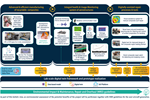Airbus officially begins operations at aircraft lifecycle center
The Airbus Lifecycle Services Centre (ALSC) unites Airbus and partners in Chengdu, China, to manage the entire aircraft lifecycle, aiming for recovery of up to 75% of stored aircraft at the facility.
On Jan. 24, the Airbus Lifecycle Services Centre (ALSC), previously announced in January 2022, officially began its operations. Based in Chengdu, China, the ALSC will offer solutions to manage the entire lifecycle of an aircraft, acting as a one-stop shop for a full range of activities — from aircraft parking and storage to maintenance, upgrades, conversions, dismantling and recycling services for various aircraft types, as well as the controlled distribution of used parts from dismantling. The ALSC is certified by the European Union Aviation Safety Agency (EASA) and the Civil Aviation Administration of China (CAAC).
The new facility covers a surface area of 717,000 square meters and has a storage capacity of 125 aircraft. The site will progressively ramp up operations between now and 2025, directly employing up to 150 employees. The main buildings have obtained the Leadership in Energy and Environmental Design (LEED) certification for their construction, which is a first step to reduce the environmental impacts of operations at the ALSC site.
“I’m glad to see the Airbus Lifecycle Services Centre enter into service in Chengdu,” Cristina Aguilar, Airbus SVP customer services, says. “It echoes our purpose to pioneer sustainable aerospace and shows our approach to environmental responsibility across the entire aircraft lifecycle. Our service center is an example of Chinese-European cooperation in the development of the circular economy for the aviation industry.”
The Airbus Lifecycle Services Centre unites, under one roof, a joint venture between Airbus, Tarmac Aerosave and the city of Chengdu, along with the Airbus company Satair. Tarmac Aerosave brings its more than 15 years of expertise in efficient aircraft storage, dismantling and recycling to the project. Located in the same center, Airbus company Satair will acquire aging aircraft and trade and distribute the used parts to complete the full scope of lifecycle services. Seventy-five percent of the aircraft stored in the center are expected to fly again after storage and upgrade by the joint venture. The remaining aircraft will be dismantled with Tarmac Aerosave’s reclamation process, recovering around 90% of the aircraft weight.
Related Content
-
Plant tour: Albany Engineered Composites, Rochester, N.H., U.S.
Efficient, high-quality, well-controlled composites manufacturing at volume is the mantra for this 3D weaving specialist.
-
Plant tour: Middle River Aerostructure Systems, Baltimore, Md., U.S.
The historic Martin Aircraft factory is advancing digitized automation for more sustainable production of composite aerostructures.
-
The potential for thermoplastic composite nacelles
Collins Aerospace draws on global team, decades of experience to demonstrate large, curved AFP and welded structures for the next generation of aircraft.














